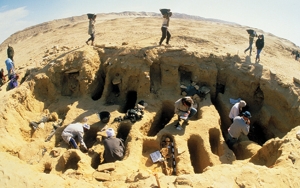Among the areas excavated at Selia was a cemetery that dates from the eighth century BC and later. In 1984, according to the official report, the archaeologists excavated 123 burials from part of the cemetery. A number of these graves included textiles, notably clothing, such as hooded robes. These appear to date to the Graeco-Roman period.
Among the recorded textiles were " ... many samples of embroidered designs. Some designs are geometric and others are symbolic including a design resembling the Egyptian Wedjet eye and some sacerdotal symbols, and there is also some representational art, including one piece of cloth adorned with brightly colored ducks...". No further details are given, nor is there an illustration of the ‘embroidered’ pieces in question. Care needs to be taken with this (initial) report, as Egyptian textiles with woven decorative motifs are often misidentified as embroidered forms.
Sources:
- GRIGGS, C. Wilfred (1988). 'Excavating a Christian cemetery near Selia, in the Fayoum region of Egypt,' in: C. Wilfred Griggs (ed.), Excavations at Selia, Egypt, Provo (Utah): Religious Studies Center, Brigham Young University, pp. 74-84.
- https://rsc.byu.edu/es/archived/excavations-seila-egypt/5-excavating-christian-cemetery-near-selia-fayum-region-egypt (retrieved 3 June 2016).
Digital source of illustration (retrieved 3 June 2016).
GVE

